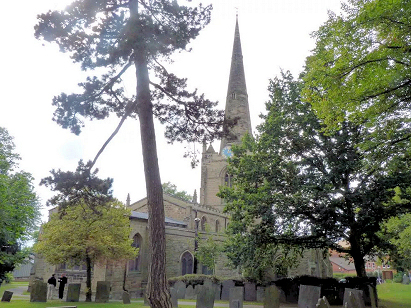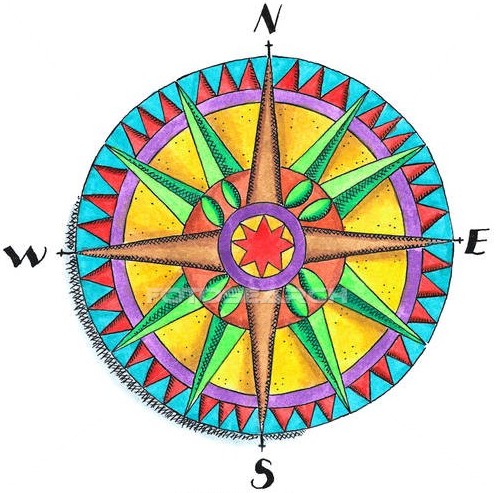
England
& Wales Hardwicke Marriage Index
Marriages
1754 - 1837
Hinckley St Mary
 |
England
& Wales Hardwicke Marriage Index |
The ParishThe parish of Hinckley lies in the extreme southwest of Leicestershire forming a stretch of the county's border with neighbouring Warwickshire, the parish boundary and that of the county too are formed by the ruler-straight line of the ancient Roman Road of Watling Street, nowadays followed by the A5 road. Hinckley is located roughly 13 miles southwest of the city of Leicester. Hinckley is a large market town which sits just northeast of where the A5 is crossed by the route of the A47 road linking Leicester with Nuneaton, the former route of the A47 once passed through the town but nowadays bypasses to the north. There is historical doubt over the origins of Hinckley's market, perhaps 1311 or more certainly issued or renewed by charter of King Edward VI in 1551. Prior to the industrial revolution market town was Hinckley's role serving as a regional trading hub and centre for specialist skills with a wider parish using a mixture of farming methods with almost equal proportions of arable and pastoral land. The first stocking frame was introduced in 1649 and by 1811 there were over 1,500 of these devices employing most of the population. Early gazetteers describe the produce as "cotton and worstead hose, particularly the former, of the coarser kind" and relate that the production here exceeded that of any similarly sized town in the land. Given the employment opportunities Hinckley expanded greatly. Twin blows reduced the trade to a mere residual level, firstly the town lost lucrative military contracts and secondly improved machinery introduced into Leicester took almost all of the residual trade reducing Hinckley to extreme poverty. Modern developments helped to prolong and diversify the town, the Ashby Canal arrived first connecting the town to the major town of Coventry and the main canal network, this was, in turn, followed by a railway line linking Leicester with Birmingham through Hinckley & Nuneaton. In more modern times Hinckley has expanded once again, its position close to major trunk roads and motorways and central English location induced many businesses to the town which has expanded to engulf nearby Burbage and has spread to form a shape not unlike a nail, broad north of the railway line but narrow and elongated to its south, the principal dimensions being of around 3 miles. Small brooks drain Hinckley southwestwards into the nearby River Anker, the latter heads westwards to meet the Tame at Tamworth and finally the mighty Trent wherein matters turn back east on that river's long journey to the North Sea arriving through the Humber Estuary. Hinckley's westernmost properties sit at around 90 metres but the town's centre stands at between 120 & 130 metres above the sea on a knoll, early gazetteers indicate that, before all of the urban developments, it commanded a view of no fewer than 50 churches from what was the local high point. Covering just short of 2,400 acres Hinckley parish was fairly typically sized for its region, the population of the town grew from close to 1,000 in the 17th century to over 7,000 by the end of this transcript period in the late 20th century it stood at over 55,000. Whilst Hinckley in Domesday times, in the control of one Earl Aubrey of Courcy, is recorded as of sufficient size to be amongst the largest 20% of settlements by population its assets are more modest, 13 ploughs backed by typical meadows & woodland indicate, merely, a large rural farming settlement. |
 |
|
|

|
| Register No | Covering Dates | Deposited With | Register Style | Quality Standard | Comments |
| 1 |
22nd April 1754 - 21st April 1775 |
Leicestershire & Rutland Record Office - Reference -
DE1135/14 |
Standard preprinted and self-numbered combined Banns &
Marriage register with 4 entries per page |
Grade 3 Register - there are sufficient quality issues
with this register to indicate that some misreads will occur
albeit few in number |
Between 1764 & the start of 1766 the register is
extremely deficient with only the dates and signature boxes
completed & in a poor hand, this may result in a few misreads,
there is also an omission where only 2 marks "x" are recorded
without names |
| 2 | 10th June 1775 - 23rd June 1791 | Leicestershire & Rutland Record Office - Reference - DE1135/15 | Standard preprinted and self-numbered Marriage register with 4 entries per page | Grade 4 Register - there are notable quality issues with this
register which may have resulted in many misreads |
The register is a scruffy and ill-kept register with rather poor handwriting, that situation is not helped by fading of the earlier sections of the register and thus may result in some misreads, there may be quite a few, users should use caution |
| 3 | 17th July 1791 - 30th December 1812 | Leicestershire & Rutland Record Office - Reference - DE1135/16 | Standard preprinted and self-numbered Marriage register with 4 entries per page | Grade 3 Register - there are sufficient quality issues with this
register to indicate that some misreads will occur albeit few in
number |
Poor handwriting continues through this register with the
possibility of further misreads |
| 4 | 4th January 1813 - 28th September 1828 | Leicestershire & Rutland Record Office - Reference - DE1135/17 | Standard Rose style preprinted and prenumbered Marriage register | Grade 1 Register - Few issues noted and a low likelihood of misreads | None |
| 5 | 28th September 1828 - 7th June 1837 | Leicestershire & Rutland Record Office - Reference - DE1135/18 | Standard Rose style preprinted and prenumbered Marriage register | Grade 2 Register - not a perfect read but with a low likelihood of
misreads |
None |
|
Stoke
Golding St Margaret
|
||
 |
||
|
Nuneaton
St Nicolas, Warwickshire
Burton Hastings St Botolph |
Corrections to Tinstaafl Transcripts